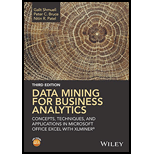
a.
Explanation of Solution
Given: The following statement:
Based on the financial as well as demographic data, decide whether a loan should be issued to an applicant or not.
To find: Whether the data mining techniques to be used belong to supervised or unsupervised learning.
Solution:
The given statement acknowledges that it is supervised learning. To issue a loan, an applicant is already registered in their
b.
Explanation of Solution
Given: The following statement:
Based on the buying patterns in prior transactions, make recommendations to the customers regarding additional items to buy.
To find:Â Whether the data mining techniques to be used belong to supervised or unsupervised learning.
Solution:
The given statement acknowledges that it is unsupervised learning. The online bookstore recommends various types of books to the customers which will not provide any possible outcome whether the recommendation was followed or not.
c.
Explanation of Solution
Given: The following statement:
Recognize the risk of data packet in network based on comparison to the other packets whose status is well-known.
To find: Whether the data mining techniques to be used belong to supervised or unsupervised learning.
Solution:
The given statement acknowledges that it is supervised learning. The network data packet can easily be recognized as dangerous (hacker attack, virus) or safe if the status of other packets is known.
d.
Explanation of Solution
Given: The following statement:
Identification of similar customer segments.
To find:Â Whether the data mining techniques to be used belong to supervised or unsupervised learning.
Solution:
The given statement acknowledges that it is unsupervised learning. In this, the dependency of an outcome is not known. To identify the segment, unsupervised learning is used so that it can easily be utilized and classify the new customers and its segments with the help of supervised learning.
e.
Explanation of Solution
Given: The following statement:
To forecast whether a company might go bankrupt on the basis of financial data from similar bankrupt and non-bankrupt companies.
To find:Â Whether the data mining techniques to be used belong to supervised or unsupervised learning.
Solution:
The given statement acknowledges that it is supervised learning as both the companies are comparing the financial data of both bankrupt and nonbankrupt firms, and the status of similar companies is known.
f.
Explanation of Solution
Given: The following statement:
Predict the recovery time of an aircraft depending on a trouble ticket.
Â
To find:Â Whether the data mining techniques to be used belong to supervised or unsupervised learning.
Solution:
The given statement acknowledges that it is supervised learning. It analyzes both the historical repairs and actual repair concerning which part is having a similar repair.
g.
Explanation of Solution
Given: The following statement:
The automated mail sorting by scanning the zip code.
To find:Â Whether the data mining techniques to be used belong to supervised or unsupervised learning.
Solution:
The given statement acknowledges that it is supervised learning. In scanning the zip code, it is likely to have the knowledge regarding whether the sorting was correct or not.
h.
Explanation of Solution
Given: The following statement:
Generate the personalized discount coupons based on the products that have been purchased recently and previously on the grocery store.
To find:Â Whether the data mining techniques to be used belong to supervised or unsupervised learning.
Solution:
The given statement acknowledges that it is unsupervised learning. In this, the purchase may vary in the grocery store where the future prediction of purchase is not cleared as compared to the previous purchases.
Want to see more full solutions like this?
Chapter 2 Solutions
Data Mining for Business Analytics: Concepts, Techniques, and Applications with XLMiner
- Please solve and answer the questions correctly please. Thank you!!arrow_forwardConsidering the TM example of binary sum ( see attached)do the step-by-step of execution for the binary numbers 1101 and 11. Feel free to use the Formal Language Editor Tool to execute it; Write it down the current state of the tape (including the head position) and indicate the current state of the TM at each step.arrow_forwardI need help on inculding additonal code where I can can do the opposite code of MatLab, where the function of t that I enter becomes the result of F(t), in other words, turning the time-domain f(t) into the frequency-domain function F(s):arrow_forward
 Management Of Information SecurityComputer ScienceISBN:9781337405713Author:WHITMAN, Michael.Publisher:Cengage Learning,
Management Of Information SecurityComputer ScienceISBN:9781337405713Author:WHITMAN, Michael.Publisher:Cengage Learning, Principles of Information Systems (MindTap Course...Computer ScienceISBN:9781305971776Author:Ralph Stair, George ReynoldsPublisher:Cengage Learning
Principles of Information Systems (MindTap Course...Computer ScienceISBN:9781305971776Author:Ralph Stair, George ReynoldsPublisher:Cengage Learning Principles of Information Systems (MindTap Course...Computer ScienceISBN:9781285867168Author:Ralph Stair, George ReynoldsPublisher:Cengage Learning
Principles of Information Systems (MindTap Course...Computer ScienceISBN:9781285867168Author:Ralph Stair, George ReynoldsPublisher:Cengage Learning Fundamentals of Information SystemsComputer ScienceISBN:9781337097536Author:Ralph Stair, George ReynoldsPublisher:Cengage Learning
Fundamentals of Information SystemsComputer ScienceISBN:9781337097536Author:Ralph Stair, George ReynoldsPublisher:Cengage Learning Systems ArchitectureComputer ScienceISBN:9781305080195Author:Stephen D. BurdPublisher:Cengage Learning
Systems ArchitectureComputer ScienceISBN:9781305080195Author:Stephen D. BurdPublisher:Cengage Learning Fundamentals of Information SystemsComputer ScienceISBN:9781305082168Author:Ralph Stair, George ReynoldsPublisher:Cengage Learning
Fundamentals of Information SystemsComputer ScienceISBN:9781305082168Author:Ralph Stair, George ReynoldsPublisher:Cengage Learning





